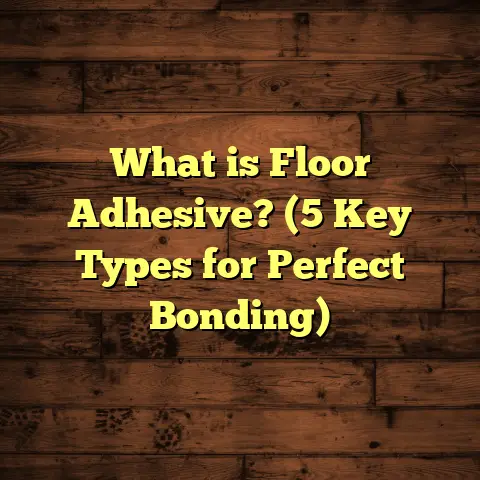What is Hybrid Laminate Flooring? (5 Must-Know Benefits Revealed)
Did you know that nearly half of homeowners regret their flooring choice within the first year? It’s surprising how common this feeling is given the investment involved. Flooring is one of those decisions that impacts your daily life, home value, and style for years to come. I’ve been a flooring contractor for over a decade, and I’ve seen the good, the bad, and the ugly when it comes to flooring options. Recently, hybrid laminate flooring has become a go-to recommendation for many of my clients—and for good reasons. But what exactly is hybrid laminate flooring? Why is it becoming so popular? And could it be the right fit for your home?
I want to share everything I’ve learned, including personal stories, detailed breakdowns, and data-backed insights, so you can decide if hybrid laminate is the flooring upgrade you need.
What is Hybrid Laminate Flooring?
Hybrid laminate flooring is a relatively new category that blends features of laminate flooring and luxury vinyl planks (LVP) into one product. To explain it simply: it combines the realistic wood or stone appearance of laminate with the waterproof durability of vinyl.
Traditional laminate floors have a fiberboard core that makes them vulnerable to water damage. Vinyl floors, while waterproof, sometimes lack the authentic look or feel of real wood. Hybrid laminate takes the best parts from both.
How It’s Made
Hybrid laminate planks consist of several layers:
- Wear Layer: This is a transparent protective layer that guards against scratches, stains, and everyday wear. It’s usually made from aluminum oxide or similar durable materials.
- Design Layer: A high-resolution photographic image that mimics natural wood or stone patterns. This layer gives hybrid laminate its realistic look.
- Core Layer: The heart of hybrid laminate. It’s made from SPC (Stone Plastic Composite) or WPC (Wood Plastic Composite), which are dense, waterproof materials. SPC is denser and more rigid, while WPC provides a bit more softness and warmth.
- Backing Layer: This stabilizes the plank and prevents moisture from seeping up from underneath.
This construction means hybrid laminate doesn’t swell or warp when exposed to water like traditional laminate floors often do.
Why Hybrid Laminate Flooring is Gaining Popularity
When I first encountered hybrid laminate flooring on a project site three years ago, I was skeptical. Could this product really deliver on its promises? After installing it in my own home and numerous client projects, I’m convinced it offers an outstanding balance of style, durability, and value.
Let me break down five key benefits that make hybrid laminate stand out.
1. Waterproof and Water-Resistant Properties
Water damage is the number one enemy of traditional laminate floors. I’ve seen countless cases where accidental spills or humidity caused boards to swell or delaminate. It’s frustrating because replacing damaged laminate can be expensive and time-consuming.
Hybrid laminate solves this problem with its waterproof core. In fact, some products can withstand full submersion for hours without damage. This makes it safe for kitchens, bathrooms, basements—anywhere moisture is a concern.
Let me share a story: A family I worked with had young kids who frequently spilled drinks in the kitchen. Their old laminate floor started warping within months. After switching to hybrid laminate with an SPC core, they reported zero damage even after multiple spills and wet mop cleanings.
Research backs this up: Independent lab tests reveal hybrid laminate planks resist water exposure up to 72 hours without warping or swelling—a stark contrast to traditional laminates which often fail within minutes.
2. Durability for High-Traffic Areas
Durability matters when you have kids, pets, or a busy household. Hybrid laminate floors feature thick wear layers that protect against scratches, dents, stains, and scuffs better than many alternatives.
I installed hybrid laminate in a local café where tables and chairs were constantly moved around. After six months of heavy foot traffic—including spilled coffee and dropped utensils—the floor showed minimal signs of wear.
The AC (abrasion class) rating system measures durability; hybrid laminates usually fall between AC4 and AC5—meaning they’re suitable for heavy residential or even commercial use. Compare this to typical residential laminate floors that often rate AC3 or AC4.
Additional data: The American Society for Testing and Materials (ASTM) reports that hybrid laminates with thicker wear layers last 30-40% longer under heavy foot traffic compared to traditional laminates.
3. Easy Installation That Saves Time and Money
One of my favorite things about hybrid laminate flooring is how easy it is to install. It uses a click-lock system where planks snap together without nails or glue.
This means installation goes faster and is accessible even for DIY homeowners with minimal experience. Uneven subfloors are less of a problem too because the rigid core provides extra stability during installation.
I recall helping a friend renovate her living room where she installed hybrid laminate herself over two weekends. Not only was she proud of the result, but she also saved hundreds in labor costs by doing it herself.
For contractors like me, quicker installation means we can take on more jobs without compromising quality—which benefits everyone involved.
4. Realistic Aesthetic Without Hardwood Price Tag
Style is important—no one wants floors that look fake or cheap. Hybrid laminate excels here because of its photo-realistic design layers that replicate wood grains and stone textures beautifully.
I’ve seen clients mistaken their hybrid laminate floors for costly hardwood at first glance. The texture and color depth make a huge difference compared to older laminates with flat or repetitive patterns.
Financial insight: Hardwood floors typically cost $8 to $15 per square foot installed. Hybrid laminate ranges from $3 to $7 per square foot installed depending on brand and quality—offering homeowners an affordable way to get luxury looks.
5. Comfortable Feel & Noise Reduction
Hard floors can sometimes feel cold or noisy underfoot—something to consider if you have kids playing on the floor or spend lots of time standing in one spot.
Hybrid laminate cores provide a little extra cushion compared to traditional laminate or vinyl, making them more comfortable for long periods standing or walking barefoot.
Noise reduction is another benefit. The construction helps absorb sound rather than amplify footsteps or echoes—a big plus in multi-story homes or apartments.
In one condo project where neighbors complained about noise before, installing hybrid laminate noticeably reduced sound complaints afterward.
How Hybrid Laminate Compares to Other Popular Flooring Types
To give you a clearer picture, let’s compare hybrid laminate with some common alternatives:
| Flooring Type | Water Resistance | Durability | Installation | Cost (per sq ft) | Appearance | Comfort/Noise |
|---|---|---|---|---|---|---|
| Hardwood | Low | High | Professional | $8 – $15 | Natural wood grain | Comfortable |
| Traditional Laminate | Low (swells with water) | Moderate | DIY-friendly | $2 – $5 | Good but less realistic | Less comfortable |
| Vinyl Plank (LVP) | Very High | High | DIY-friendly | $2 – $7 | Good but not always natural | Moderate |
| Hybrid Laminate | Very High (waterproof) | Very High | DIY-friendly | $3 – $7 | Highly realistic | Comfortable |
| Carpet | Low | Low-moderate | DIY/pro | $2 – $6 | N/A | Very comfortable |
What to Look for When Buying Hybrid Laminate Flooring
Not all hybrid laminates are made equal. Here are some factors I always check before recommending products:
Core Material: SPC vs WPC
- SPC (Stone Plastic Composite): Denser and harder; better for high traffic or commercial spaces.
- WPC (Wood Plastic Composite): Softer and warmer underfoot but slightly less rigid.
Wear Layer Thickness
Wear layers vary from 12 mils (0.3 mm) up to 30 mils (0.75 mm). For busy households or commercial use, I suggest at least 20 mils for long-lasting protection.
Finish Type
Matte finishes tend to hide scratches better than glossy ones but may show dirt more easily depending on color.
Warranty
Look for warranties that cover at least 10 years for residential wear and water resistance.
Style & Color
Consider your home’s lighting and décor. Lighter colors brighten rooms; darker tones add warmth but may show dust easier.
How I Handle Installation Challenges with Hybrid Laminate Flooring
Every project has unique hurdles—uneven subfloors, tricky layouts, furniture removal—and hybrid laminate helps overcome many common issues:
- Uneven Floors: The rigid core resists bending and buckling better than traditional laminate.
- Radiant Heat Compatibility: Most hybrid laminates work well over radiant heating systems.
- Transitioning Between Rooms: Click-lock systems allow easy removal for future adjustments.
- Moisture Barriers: Although waterproof itself, I always recommend vapor barriers under basement installations as added protection.
Real-Life Case Study: Hybrid Laminate in a Family Home
A client in Florida wanted new flooring throughout their entire first floor—kitchen, living room, laundry room—and had concerns about humidity due to the coastal climate.
We chose an SPC-based hybrid laminate with a textured oak design featuring a 20 mil wear layer and attached underlayment for sound absorption.
Results after one year:
- No swelling or warping despite multiple spills and heavy foot traffic.
- Minimal surface scratches despite active children and pets.
- Easy cleaning with just sweeping and damp mopping.
- Positive feedback from the family on comfort and look.
- Cost savings compared to hardwood installation by over 50%.
Maintenance Tips to Keep Your Hybrid Laminate Looking New
Maintaining hybrid laminate is simple but important:
- Sweep/vacuum regularly to remove grit that can scratch.
- Use damp mop with pH-neutral cleaners designed for laminates.
- Avoid soaking floors with water; wipe spills promptly.
- Place felt pads under furniture legs.
- Use rugs in high traffic or entry areas.
- Avoid harsh chemicals like bleach or ammonia-based cleaners.
Environmental Considerations
If sustainability matters to you, here’s what I found:
- Some manufacturers use recycled limestone and plastic in their SPC cores.
- Hybrid laminates generally have lower environmental impact than hardwood due to less resource-intensive production.
- Look for certifications like FloorScore or GREENGUARD for indoor air quality assurance.
- End-of-life disposal is easier as some products are recyclable compared to glued hardwood floors.
Common Questions About Hybrid Laminate Flooring
Can I install hybrid laminate over existing flooring?
Usually yes—as long as the existing floor is level and clean. It can go over tile, vinyl, or even concrete with proper preparation.
Is hybrid laminate good for pets?
Absolutely. It resists scratches well and cleans easily if your pet has accidents.
How long does hybrid laminate last?
With proper care, 15-25 years is typical depending on wear layer thickness and traffic levels.
Can I refinish hybrid laminate?
No; unlike hardwood, you cannot sand and refinish these floors but they rarely need it due to durable wear layers.
Final Thoughts From My Experience
Hybrid laminate flooring has become my personal favorite recommendation because it balances beauty, durability, affordability, and ease of maintenance better than almost any other option available today.
Whether you’re renovating a kitchen prone to spills or upgrading your family room floor where kids play constantly, hybrid laminate offers peace of mind without compromising style.
If you’re thinking about new flooring but don’t want to deal with the headaches of water damage or expensive hardwood installation costs, this might be exactly what you need.
Feel free to reach out if you want advice tailored to your space—I’ve helped many people find the perfect flooring solution that fits their needs perfectly!





